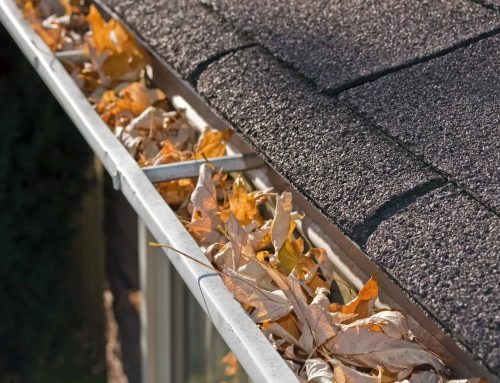Fall is your last opportunity to protect your basement from winter water damage before Toronto’s harsh weather arrives. With proper preparation focusing on your roof, eavestroughs, downspouts, and drainage systems, you can prevent costly basement flooding and water damage during the challenging months ahead.
Toronto’s winter brings unique challenges that can overwhelm unprepared homes. From heavy snowfall that melts rapidly during chinook events to freezing rain that creates ice dams, plus the notorious spring thaw that can dump massive amounts of water around your foundation, your home’s exterior water management systems face intense pressure. The key to basement protection lies in ensuring every component of your drainage system functions flawlessly before winter weather arrives.
Understanding Toronto’s Winter Water Challenges
Toronto’s climate creates a perfect storm of conditions that can lead to basement water problems. The city experiences an average of 115-130cm of snowfall annually, combined with freeze-thaw cycles that can occur multiple times throughout winter. These conditions create unique challenges that homeowners must address proactively.
The Science Behind Winter Water Damage
Winter water damage typically occurs through several mechanisms that are particularly problematic in Toronto’s climate. Ice dams form when heat escapes through your roof, melting snow that then refreezes at the eaves, creating barriers that force water under shingles and into your home. Frozen downspouts can cause eavestrough overflow, directing water against your foundation instead of away from it.
Ground saturation from autumn rainfall, combined with frozen soil that prevents proper drainage, creates conditions where spring snowmelt has nowhere to go except toward your foundation. When Toronto experiences rapid temperature swings, this can happen multiple times throughout winter, not just during the spring thaw.
Local Weather Patterns and Risk Factors
The Greater Toronto Area’s position on Lake Ontario creates microclimate effects that can intensify water management challenges. Lake-effect snow can create localized heavy accumulations, while the urban heat island effect can cause uneven melting patterns across the city.
Toronto’s clay-heavy soil conditions in many neighborhoods compound these challenges. Clay soil expands when wet and contracts when dry, creating pressure against foundation walls while simultaneously reducing drainage capacity during wet periods.
Comprehensive Roof Inspection and Maintenance
Your roof serves as the first line of defense against winter water infiltration, making a thorough fall inspection essential for basement protection. Even minor roof issues can lead to significant water problems during Toronto’s challenging winter conditions.
Critical Roof Components to Examine
Begin your roof inspection by examining shingles for loose, cracked, or missing pieces that could allow water penetration. Pay particular attention to areas around chimneys, vents, and skylights where flashing provides critical water protection. In Toronto’s freeze-thaw environment, even small gaps can quickly become major problems as water freezes and expands.
Check for proper attic ventilation and insulation, as inadequate ventilation contributes to ice dam formation. Your attic temperature should remain close to outdoor temperatures to prevent uneven snow melting. Inspect soffit and ridge vents for blockages that could compromise air circulation.
Professional vs. DIY Inspection Considerations
While homeowners can perform basic visual inspections from ground level, professional roof inspections provide a comprehensive assessment of components that aren’t easily visible. Professional roofing contractors have the experience to identify subtle signs of potential problems and can safely access all roof areas.
Given Toronto’s specific climate challenges, professional inspections often reveal issues that untrained eyes might miss, such as subtle flashing problems or ventilation inadequacies that could lead to winter water damage.
Timing Your Roof Maintenance
Complete roof maintenance before Toronto’s first significant snowfall, typically occurring between late November and early December. This timing ensures repairs can be completed in favorable weather conditions and before winter stress tests your roof’s integrity.
Address any identified issues immediately, as winter weather can rapidly worsen minor problems. Small leaks can become major failures when subjected to freeze-thaw cycles and ice dam conditions.
Eavestrough System Optimization for Winter Protection
Your eavestrough system plays a crucial role in directing water away from your foundation, but Toronto’s winter conditions can quickly compromise its effectiveness without proper preparation and maintenance.
Thorough Cleaning and Debris Removal
Remove all leaves, twigs, and debris from eavestroughs and downspouts before winter arrives. Even small accumulations can freeze solid, creating blockages that force water to overflow near your foundation. Toronto’s abundant urban trees mean eavestrough cleaning is particularly critical in fall.
Pay special attention to downspout outlets and underground drainage connections, as these areas commonly experience blockages that aren’t immediately visible. Use a hose to test water flow through the entire system, ensuring proper drainage to discharge points.
Slope and Alignment Verification
Verify that eavestroughs maintain proper slope toward downspouts, typically 1/4 inch per 10 feet of eavestrough length. Toronto’s freeze-thaw cycles can shift eavestrough alignment over time, creating low spots where water pools and potentially freezes.
Check eavestrough attachment points for security, as loose brackets can allow sections to sag and disrupt proper water flow. Ice accumulation can place significant stress on poorly secured eavestroughs, potentially causing failure during winter storms.
Downspout Performance and Extensions
Ensure downspouts direct water at least 6 feet away from your foundation, preferably farther on Toronto’s clay soils that drain poorly. Consider installing splash blocks or underground drainage extensions to improve water dispersal away from your home.
Test downspout capacity by running water through the system during your fall maintenance. Slow drainage or overflow indicates blockages that must be cleared before winter weather arrives.
Ice Dam Prevention Strategies
Install heating cables in eavestroughs and downspouts if ice dam formation has been problematic in previous years. These systems prevent ice accumulation that can force water backup into your roof structure.
Consider eavestrough guards or leaf protection systems to minimize debris accumulation throughout winter, reducing the likelihood of ice-related blockages during freeze-thaw cycles.

Foundation and Drainage System Preparation
Proper foundation drainage is essential for preventing basement water infiltration during Toronto’s challenging spring thaw and winter rain events. Fall preparation ensures these systems function effectively when needed most.
Exterior Foundation Inspection
Walk around your home’s perimeter, examining the foundation for cracks or gaps that could allow water entry. Pay particular attention to areas where different materials meet, such as where concrete foundations meet brick or stone construction.
Check that soil grades away from your foundation with a minimum 6-inch drop over the first 10 feet. Toronto’s clay soils can shift over time, creating depressions that direct water toward rather than away from your foundation.
Window Well and Basement Entry Maintenance
Clean window wells thoroughly, removing debris and checking drainage systems. Install or verify window well covers to prevent snow and rain accumulation that could lead to basement water infiltration.
Inspect basement entrance doors and stairwells for proper drainage and weatherproofing. These areas are particularly vulnerable during rapid snowmelt events common in Toronto’s climate.
Sump Pump and Backup System Testing
Test your sump pump operation by pouring water into the sump pit until the pump activates. Verify that discharge lines are clear and direct water well away from your foundation. Consider installing a battery backup system to maintain protection during power outages that commonly accompany winter storms.
Check that your sump pump discharge doesn’t freeze during winter, as blocked discharge lines can cause pump failure and basement flooding. Insulate exposed portions of discharge lines or install freeze-prevention accessories as needed.
French Drain and Perimeter System Maintenance
If your home has French drains or other perimeter drainage systems, verify they’re functioning properly before winter. Clear any visible obstructions and ensure discharge points remain open throughout winter months.
Consider professional inspection of underground drainage systems if you’ve experienced basement water issues in previous years, as these systems can develop blockages that aren’t easily detected without specialized equipment.
Water Management and Landscaping Adjustments
Strategic landscaping and water management techniques provide additional protection against basement water infiltration during Toronto’s challenging weather conditions.
Strategic Grading and Soil Management
Ensure proper grading directs surface water away from your foundation. Add soil as needed to maintain positive drainage, particularly in areas where settling has occurred over time. Use clay-resistant soil amendments in Toronto’s heavy clay areas to improve drainage capacity.
Consider installing surface drainage features such as swales or drainage channels in problem areas where water tends to accumulate near your foundation during heavy rainfall or snowmelt events.
Plant Selection and Root Management
Remove vegetation growing too close to your foundation, as roots can damage foundation walls and drainage systems. Choose plants with non-invasive root systems for areas near your home’s perimeter.
Trim tree branches that overhang your roof, as these can deposit debris in eavestroughs and create ice dam risks when branches retain snow and ice above your roofline.
Seasonal Water Feature Preparation
Disconnect and drain garden hoses, irrigation systems, and outdoor water features before freezing weather arrives. Frozen hoses connected to exterior spigots can cause pipes to burst, creating water damage risks.
Install insulated covers on exterior spigots and consider shutting off interior water supplies to prevent freeze damage that could lead to water infiltration issues.
Professional Assessment and Maintenance Planning
While homeowners can handle many fall preparation tasks, professional assessment ensures comprehensive protection against winter water damage and identifies issues that might not be apparent to untrained observers.
When to Call Professionals
Schedule professional inspections if you’ve experienced basement water issues in previous years, as recurring problems often indicate systemic issues that require expert diagnosis and correction. Professional assessment is also recommended for older Toronto homes where drainage systems may not meet current standards.
Consider professional evaluation if your home is located in areas known for drainage challenges, such as properties built on former creek beds or in low-lying areas of Toronto where water management is particularly critical.
Comprehensive System Integration
Professional contractors can evaluate how all components of your water management system work together, identifying weak points that could fail during winter stress conditions. This holistic approach often reveals optimization opportunities that improve overall system performance.
Expert assessment includes evaluation of whether your current systems are adequate for Toronto’s specific climate challenges and whether upgrades could provide better long-term protection against basement water damage.
Maintenance Scheduling and Prevention
Develop a maintenance schedule that addresses Toronto’s specific seasonal challenges, including timing for eavestrough cleaning, roof inspections, and drainage system testing. Professional contractors can provide customized maintenance plans based on your home’s specific needs and local conditions.
Consider establishing relationships with qualified contractors before emergency situations arise, as winter storms can create high demand for emergency repair services when prompt response is most critical.
Protecting Your Home with Proactive Fall Preparation
A leak-free basement this winter starts with comprehensive fall preparation that addresses every component of your home’s water management system. From roof maintenance to foundation drainage, each element plays a critical role in protecting your basement from Toronto’s challenging winter conditions.
The key to success lies in systematic preparation that considers how different systems work together to manage water effectively. By addressing potential issues before winter arrives, you can prevent costly damage and ensure your basement remains dry throughout the season.
Ready to ensure your basement stays dry this winter? Contact our team for a comprehensive fall assessment that covers all aspects of your home’s water management system. Let us help you complete the essential preparations that will keep your basement leak-free throughout Toronto’s challenging winter season.








